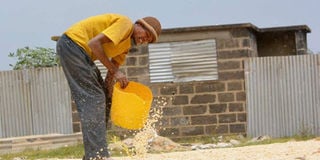Why Devolution ministry is at the centre of ‘Big Four’

A man dries maize at a cereal store in Nakuru County on January 11, 2018. Food security has been considered a priority by the national government. PHOTO | SILA KIPLAGAT | NATION MEDIA GROUP
What you need to know:
- Thwake Dam in Makueni County is a good example of the actions by the national government aimed at food security.
- The national and county governments ought to come up with incentives to attract investors in the manufacturing sector.
A critical look at President Uhuru Kenyatta’s new Cabinet presents the need for Kenyans to focus on what the Head of State outlined as his main agenda during his second and final term.
The appointment of Eugene Wamalwa to head the Devolution docket is a stamp of confidence by President Kenyatta in the Cabinet Secretary’s role in achieving the “Big Four” pillars — food security, affordable housing, universal healthcare and manufacturing — that will define the leader’s legacy.
Schedule 4 of the Constitution, which designates functions to the national and county governments, shows that most of the “Big Four” agenda items fall under shared functions with policy formulation left to the national government while execution and implementation falls under the county governments.
FOOD SECURITY
This then means that the ability of the President to fulfill his mission will highly depend on the level of cooperation and partnership between his government and the regional governments.
For instance, on food security, the role of the national government is limited to policy formulation while the counties handle crop and animal husbandry, livestock sale yards, county abattoirs, plant and animal disease control and fisheries.
Hence, the only way the President will ensure food security is by working closely with the counties, where the production is.
In particular, efforts of the Ministry of Agriculture and that of Water and Irrigation have to be deliberately directed at meaningful partnerships and working relationships with counties.
A good example is the recently launched dam in Kirinyaga County, which is a national government project aimed at expanding the rice-growing Mwea Irrigation Scheme.
The county government can then ensure that matters such as handling crop disease and marketing of the produce are effectively dealt with.
FINANCIAL MANAGEMENT
Thwake Dam in Makueni County is another good example of the actions by the national government aimed at food security.
Once completed, the dam is expected to provide water for drinking and irrigation to an expansive area.
We hope to see the Makueni County government move in to provide the necessary information and technical expertise to residents to uplift their lives.
As the bridge between the two levels of government, the Devolution ministry, by its very nature, will be expected to take the front line in ensuring it happens.
Sharing of resources between the two tiers in regard to the shared functions has to be done in a way that gives taxpayers the best value for money.
HEALTHCARE
This is also true of the healthcare pillar, where the role of the national government is limited to policy formulation and management of the only two national referral hospitals.
The rest of the functions are under the counties.
This, again, means the only way the President’s dream of affordable and universal healthcare will be realised is by ensuring that county governments succeed in their mandate to provide quality health services.
The same applies to provision of affordable housing.
Counties own most of the land and, being in charge of development control, are natural allies in any agenda on affordable housing.
HOUSING
The national government, through the National Housing Corporation (NHC), used to partner with the defunct local authorities to provide housing for residents.
Resumption of such agreements and initiation of new ones would go a long way in actualising affordable housing.
The planned urban renewal by Nairobi County targeting the old City Council estates in Eastlands also provides a golden opportunity for the President in achieving his goal.
It has been encouraging to see counties such as Uasin Gishu moving towards the establishment of industrial zones because that is a sure way of creating wealth and employment for our youth.
Other counties should follow suit, providing a conducive environment for setting up of manufacturing plants.
INVESTORS
Value addition initiatives like the Makueni County fruit processing plant is the way to go.
The national and county governments ought to come up with incentives to attract investors in the manufacturing sector, ranging from fair tax practices to provision of affordable land for plants.
It would be good to track how a similar model by Machakos County worked out.
Evidently, the Summit — the body chaired by the President and comprising all the 47 Governors — needs to agree on the key areas of cooperation.
Mr Kavemba is an expert in governance and constitutional issues. [email protected]; Mr Fwamba is an Advisor of Devolution and ASALs Cabinet Secretary Eugene Wamalwa. [email protected].




